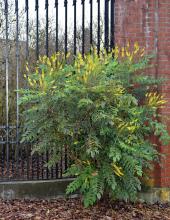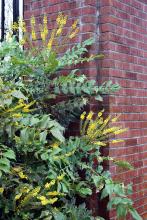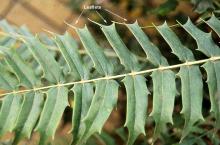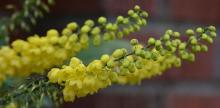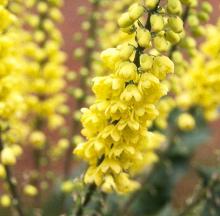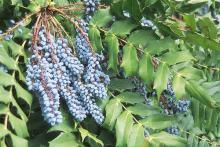Mahonia lomariifolia
Common name:
Chinese Mahonia
Burmese Mahonia
Chinese Hollygrape
Pronunciation:
ma-HO-ni-a low-mah-ree-i-FO-lee-a
Family:
Berberidaceae
Genus:
Synonyms:
Berberis lomariifolia
Mahonia oiwakensis
Mahonia oiwakensis subsp. lomariifolia
Berberis oiwakensis
Type:
Broadleaf
Native to (or naturalized in) Oregon:
No
- Evergreen shrub, 6-12 ft (1.8-3.7 m), very erect, may be single or multistemmed, stems little branched. Leaves alternate, pinnately compound, clustered near stem ends and held horizontal, very long, each is 40-60 cm long, with 10-18 pairs of leaflets which are thick, spiny, glossy green, and about 7.5 x 2 cm. Flowers small, bright yellow, appear in winter and are borne in long (10-20 cm), upright, cylindrical clusters just above the upper most leaves. Fruit is a powder blue.
- Part shade, especially in the afternoon, moist, well drained soil. May need protection from cold in much of the Pacific Northwest. Used as a specimen plant.
- Hardy to USDA Zone (7) 8 Native to Burma (Myanmar), western China and Taiwan.
- Taxonomy: In the World Flora Online (WFO) the accepted name for this species is Berberis oiwakensis, with Mahonia oiwakensis as a synonym. "This species has long been known by the name Mahonia lomariifolia, published by Takeda in 1917. Under that name, it was considered to occur only in mainland China, while on Taiwan, a second species was found, known as M. oiwakensis. Modern taxonomic sources unite the two as a single species, but as the latter name was published a year earlier by Hayata, it has priority and is thus the accepted name" (Wikipedia).
- Mahonia: after Bernard McMahon (born 1816), American nurseryman. lomariifolia: with leaves like Lomaria, now Blechnum.
- Oregon State Univ., campus: at the 11th Street Gate on Campus Way

